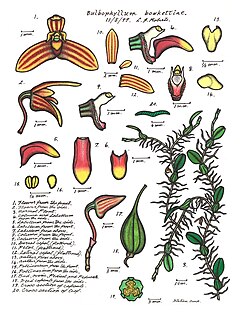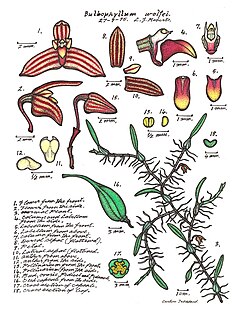
Bulbophyllum bowkettiae, commonly known as the striped snake orchid, is a species of epiphytic or lithophytic orchid with thin, creeping rhizomes and flattened pseudobulbs each with a single tough, dark green leaf and a single cream-coloured flower with red stripes. It grows on trees and rocks in rainforest in tropical North Queensland, Australia.
Bulbophyllum argyropus, commonly known as the silver strand orchid, is a species of epiphytic or sometimes lithophytic orchid that is endemic to eastern Australia, including Lord Howe and Norfolk Islands. It has crowded pseudobulbs, tough, dark green leaves and up to four small whitish to yellowish flowers with an orange labellum.

Bulbophyllum baileyi, commonly known as the fruit fly orchid, is a species of epiphytic or lithophytic orchid that is native to Queensland and New Guinea. It has coarse, creeping rhizomes, curved, yellowish pseudobulbs with a single thick, fleshy leaf, and a single cream-coloured flower with yellow, red or purple spots. It grows on trees and rocks in open forest, often in exposed places.
Bulbophyllum boonjee commonly known as the maroon strand orchid, is a species of epiphytic orchid that is endemic to tropical North Queensland. It has crowded, flattened pseudobulbs, stiff, pale green leaves and up to four small, bell-shaped maroon flowers with darker stripes.
Bulbophyllum bracteatum, commonly known as the blotched pineapple orchid, is a species of epiphytic or sometimes lithophytic orchid that is endemic to eastern Australia. It has crowded pseudobulbs, tough, pale green or yellowish leaves and up to twenty five cream-coloured to yellowish flowers with purplish or reddish blotches. It usually grows in the tops of rainforest trees.

Bulbophyllum elisae, commonly known as the pineapple orchid, is a species of epiphytic or lithophytic orchid that is endemic to eastern Australia. It has crowded, wrinkled, pale green or yellowish clump-forming pseudobulbs, stiff, pale green to yellowish leaves and between three and twelve pale green to dark green flowers with a dark red to purple labellum. It usually grows in the tops of rainforest trees, on cliff faces or boulders.
Bulbophyllum evasum, commonly known as the creeping brittle orchid, is a species of epiphytic or lithophytic orchid with creeping brittle rhizomes, small, stubby pseudobulbs and dark green, fleshy leaves. The flowers are small, pink to reddish with dark stripes and yellow tips, clustered on the end of a dark red flowering stem. This orchid grows in rainforest on tree trunks and branches as well as on rocks, in tropical North Queensland.
Bulbophyllum johnsonii, commonly known as the yellow snake orchid, is a species of epiphytic or lithophytic orchid that has a thin, creeping rhizome with flattened pseudobulbs, each with a single tough, dark green leaf and a single bright yellow to orange flower on a thread-like stalk. It grows on trees, shrubs and rocks in and near rainforest in tropical North Queensland.
Bulbophyllum lageniforme, commonly known as the smooth strand orchid, is a species of epiphytic or lithophytic orchid that is endemic to tropical North Queensland. It has flattened, pale green, grooved, clump-forming pseudobulbs, stiff, dark green leaves and up to four cream-coloured or pale green flowers with a pink labellum. It usually grows on shrubs, trees and rocks in highland rainforest.
Bulbophyllum lilianae, commonly known as the warty strand orchid, is a species of epiphytic or lithophytic orchid that is endemic to tropical North Queensland. It has widely spaced, deeply grooved, dark green to yellowish pseudobulbs, thin but tough, dark green to yellowish leaves and up to three cream-coloured, pale green or reddish flowers with dark red stripes and a pink labellum. It grows on shrubs, trees and rocks, often in exposed situations.

Bulbophyllum longiflorum, commonly known as the pale umbrella orchid, is a species of epiphytic or lithophytic orchid. It has a creeping rhizome, widely spaced, dark green pseudobulbs with a single large, fleshy leaf, and flowers spreading in a semicircular umbel, resembling one-half of an umbrella. The flowers are canoe-shaped, greenish cream-coloured to yellowish with purple dots. It has a wide distribution and is found in parts of Africa, on islands in the Indian and Pacific Oceans, Southeast Asia, New Guinea and northern Australia.
Bulbophyllum macphersonii, commonly known as eyelash orchids, is a species of epiphytic or lithophytic orchid that is endemic to Queensland. It has tiny, crowded, slightly flattened, dark green pseudobulbs, a single thick, fleshy leaf and a single dark red to purplish red flower with a narrow labellum. It grows on trees and rocks in sheltered places.
Bulbophyllum nematopodum, commonly known as the green cowl orchid, is a species of epiphytic or lithophytic orchid that has small, flask-shaped pseudobulbs pressed against the surface on which it grows. Each pseudobulb has roots at its base, a single shiny, fleshy leaf and a single cream-coloured flower with red spots on its top. It grows on trees and rocks in rainforest and is endemic to tropical North Queensland.
Bulbophyllum radicans, commonly known as the striped pyjama orchid, is a species of epiphytic or lithophytic orchid with long, hanging stems with roots near the base and covered with brown, papery bracts which partially hide the pseudobulbs. Each pseudobulb has a single thin leaf. A single small pink, cream-coloured or yellow flower with red or purplish stripes is borne on a thin flowering stem that emerges from the base of the psudobulb. This orchid grows on trees or rocks in or near rainforest in tropical North Queensland.

Bulbophyllum shepherdii, commonly known as the wheat-leaf rope orchid, is a species of epiphytic or lithophytic orchid that forms a dense mat of branching rhizomes pressed against the surface on which it grows. The pseudobulbs are well spaced along the rhizome, each with a single egg-shaped leaf and a single small, white or cream-coloured flower with yellow tips. It grows on trees and rocks in rainforest and is endemic to eastern Australia.

Bulbophyllum wadsworthii, commonly known as the yellow rope orchid, is a species of epiphytic or lithophytic orchid that forms clumps that hang off the surface on which the plant is growing. The pseudobulbs are small and partly hidden by brown, papery bracts. Each pseudobulb has a single fleshy, dark green leaf and a single star-shaped, cream-coloured or pale green flower with an orange labellum. It mainly grows on trees and rocks in rainforest and is endemic to Queensland.

Bulbophyllum wolfei, commonly known as the fleshy snake orchid, is a species of epiphytic or lithophytic orchid with thin, creeping rhizomes, and flattened pseudobulbs each with a single thick, fleshy, dark green leaf and a single cream-coloured flower with dark red stripes. It mostly grows on rainforest trees in tropical North Queensland.
Liparis nugentiae, commonly known as the large sphinx orchid, is a plant in the orchid family and is endemic to Queensland. It is an epiphytic or lithophytic orchid which forms clumps with flattened pseudobulbs, two to four thin leaves and up to twenty greenish or pale yellow flowers. It grows in rainforest at altitudes above 600 m (2,000 ft) in tropical far North Queensland.

Dendrobium adae, commonly known as the slender cane orchid, is an epiphytic, sometimes lithophytic orchid in the family Orchidaceae. It has cylindrical pseudobulbs, up to four dark green leaves and up to six white or greenish to apricot-coloured flowers. It grows in tropical North Queensland, Australia.

Dendrobium toressae, commonly known as the sparkle orchid or mica orchid, is a species of epiphytic or lithophytic orchid with highly branched stems forming dense patches. The leaves are crowded, fleshy and dark green with a glittery surface. A single cream-coloured to pale pink flower with a yellow labellum develops in a leaf axil. It is endemic to tropical North Queensland.









